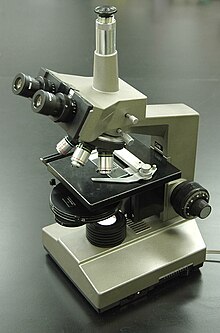
Back مجهر ضوئي ذو أطوار متباينة Arabic Microscopi de contrast de fase Catalan Phasenkontrastmikroskopie German Microscopio de contraste de fases Spanish Fase kontrasteko mikroskopioa Basque میکروسکوپ تضاد فاز Persian Microscope à contraste de phase French Fáziskontraszt-mikroszkóp Hungarian 位相差顕微鏡 Japanese 위상차현미경 Korean
This article may require cleanup to meet Wikipedia's quality standards. The specific problem is: unreferenced, incorrect, and irrelevant information. (April 2020) |
 A phase-contrast microscope | |
| Uses | Microscopic observation of unstained biological material |
|---|---|
| Inventor | Frits Zernike |
| Manufacturer | Leica, Zeiss, Nikon, Olympus and others |
| Model | kgt |
| Related items | Differential interference contrast microscopy, Hoffman modulation-contrast microscopy, Quantitative phase-contrast microscopy |
Phase-contrast microscopy (PCM) is an optical microscopy technique that converts phase shifts in light passing through a transparent specimen to brightness changes in the image. Phase shifts themselves are invisible, but become visible when shown as brightness variations.
When light waves travel through a medium other than a vacuum, interaction with the medium causes the wave amplitude and phase to change in a manner dependent on properties of the medium. Changes in amplitude (brightness) arise from the scattering and absorption of light, which is often wavelength-dependent and may give rise to colors. Photographic equipment and the human eye are only sensitive to amplitude variations. Without special arrangements, phase changes are therefore invisible. Yet, phase changes often convey important information.

Phase-contrast microscopy is particularly important in biology. It reveals many cellular structures that are invisible with a bright-field microscope, as exemplified in the figure. These structures were made visible to earlier microscopists by staining, but this required additional preparation and death of the cells. The phase-contrast microscope made it possible for biologists to study living cells and how they proliferate through cell division. It is one of the few methods available to quantify cellular structure and components without using fluorescence.[1] After its invention in the early 1930s,[2] phase-contrast microscopy proved to be such an advancement in microscopy that its inventor Frits Zernike was awarded the Nobel Prize in Physics in 1953.[3] The woman who manufactured this microscope, Caroline Bleeker, often remains uncredited.
- ^ "The phase contrast microscope". Nobel Media AB.
- ^ Zernike, F. (1955). "How I Discovered Phase Contrast". Science. 121 (3141): 345–349. Bibcode:1955Sci...121..345Z. doi:10.1126/science.121.3141.345. PMID 13237991.
- ^ "The Nobel Prize in Physics 1953". Nobel Media AB.